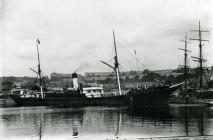Content can be downloaded for non-commercial purposes, such as for personal use or in educational resources.
For commercial purposes please contact the copyright holder directly.
Read more about the The Creative Archive Licence.
Description
Over 50 vessels belonging to the port of Cardiff are believed to have been lost due to torpedos, mines, or by being bombed or purposely scuttled after capture during the Great War .
The CAMBANK was built by John Readhead & Sons, South Shields, in 1899. It was built for Sir Walter J Runciman (Walter Runciman & Co). The ship was sold to the Merevale Shipping Co of Cardiff in 1913, who changed the vessel's name to CAMBANK to fit with the line's own naming tradition (e.g. CAMROSE, CAMWELL, CAMDALE, CAMLAKE, etc). At time of loss, William Evans Thomas, was the nominated manager of 17 Merchants Exchange Bute Street.
A selection of pages from one of surviving crew lists held by Glamorgan Archives is shown in the image above. These documents suggest that the regular crew included Thomas R Prescott as master, W Williams of Carmarthen as Mate, W E Rothbottom of Pencoed, Engineer; George Dring of Carrbridge, Donkeyman; and George Webb of Carrbridge, pilot.
The CAMBANK was travelling from Huelva to Garston with a cargo of copper, when, soon after picking up a pilot, it was torpedoed by German U-30 at 11am on 20 February 1915. The sound of the explosion was heard ashore and was a signal for the lifeboat to be launched. Although three lives were lost in the initial explosion and a fourth man drowned during the evacuation of the ship, 21 survivors reached the ship's two lifeboats. These were taken in tow by the Bull Bay lifeboat until picked up by the armed yacht ORIANA, which then towed all three back to Amlwch.
The CAMBANK broke in two and sank 20 minutes after being attacked.
The crewmen commemorated on the memorial for merchant sailors and fishermen at Tower Hill, London, are as follows:
Joseph Wilson Boyle, Third Engineer;
Michael Lynch, Fireman and Trimmer;
Robert Quigley, Donkeyman;
Charles Sinclair, Fireman and Trimmer.
The wreck lies on the seabed off Point Lynas, Anglesey. The bow section is lying on its port side and the stern collapsed. Much of the midships of the vessel has been flattened as a result of salvage in the 1950s.
http://glamarchives.gov.uk/
















Do you have information to add to this item? Please leave a comment
Comments (0)
You must be logged in to leave a comment